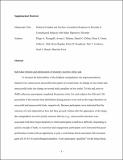| dc.contributor.author | Pizzagalli, Diego | |
| dc.contributor.author | Holmes, Avram J. | |
| dc.contributor.author | Dillon, Daniel G. | |
| dc.contributor.author | Goetz, Elena L. | |
| dc.contributor.author | Birk, Jeffrey L. | |
| dc.contributor.author | Bogdan, Ryan | |
| dc.contributor.author | Dougherty, Darin D. | |
| dc.contributor.author | Iosifescu, Dan V. | |
| dc.contributor.author | Rauch, Scott L. | |
| dc.contributor.author | Fava, Maurizio | |
| dc.date.accessioned | 2009-09-23T15:00:11Z | |
| dc.date.issued | 2009 | |
| dc.identifier.citation | Pizzagalli, Diego A., Avram J. Holmes, Daniel G. Dillon, Elena L. Goetz, Jeffrey L. Birk, Ryan Bogdan, Darin D. Dougherty, Dan V. Iosifescu, Scott L. Rauch, and Maurizio Fava. 2009. Reduced Caudate and Nucleus Accumbens Response to Rewards in Unmedicated Individuals With Major Depressive Disorder. The American Journal of Psychiatry 166: 702-710. | en_US |
| dc.identifier.issn | 0002-953X | en_US |
| dc.identifier.issn | 1535-7228 | en_US |
| dc.identifier.uri | http://nrs.harvard.edu/urn-3:HUL.InstRepos:3311527 | |
| dc.description.abstract | Objective: Major depressive disorder is characterized by impaired reward processing, possibly due to dysfunction in the basal ganglia. However, few neuroimaging studies of depression have distinguished between anticipatory and consummatory phases of reward processing. Using functional MRI (fMRI) and a task that dissociates anticipatory and consummatory phases of reward processing, the authors tested the hypothesis that individuals with major depression would show reduced reward-related responses in basal ganglia structures. Method: A monetary incentive delay task was presented to 30 unmedicated individuals with major depressive disorder and 31 healthy comparison subjects during fMRI scanning. Whole-brain analyses focused on neural responses to reward-predicting cues and rewarding outcomes (i.e., monetary gains). Secondary analyses focused on the relationship between anhedonic symptoms and basal ganglia volumes. Results: Relative to comparison subjects, participants with major depression showed significantly weaker responses to gains in the left nucleus accumbens and the caudate bilaterally. Group differences in these regions were specific to rewarding outcomes and did not generalize to neutral or negative outcomes, although relatively reduced responses to monetary penalties in the major depression group emerged in other caudate regions. By contrast, evidence for group differences during reward anticipation was weaker, although participants with major depression showed reduced activation to reward cues in a small sector of the left posterior putamen. In the major depression group, anhedonic symptoms and depression severity were associated with reduced caudate volume bilaterally. Conclusions: These results suggest that basal ganglia dysfunction in major depression may affect the consummatory phase of reward processing. Additionally, morphometric results suggest that anhedonia in major depression is related to caudate volume. | en_US |
| dc.description.sponsorship | Psychology | en_US |
| dc.language.iso | en_US | en_US |
| dc.publisher | American Psychiatric Association | en_US |
| dc.relation.isversionof | http://dx.doi.org/10.1176/appi.ajp.2008.08081201 | en_US |
| dash.license | OAP | |
| dc.title | Reduced Caudate and Nucleus Accumbens Response to Rewards in Unmedicated Subjects with Major Depressive Disorder | en_US |
| dc.type | Journal Article | en_US |
| dc.description.version | Accepted Manuscript | en_US |
| dc.relation.journal | The American Journal of Psychiatry | en_US |
| dash.depositing.author | Pizzagalli, Diego | |
| dc.date.available | 2009-09-23T15:00:11Z | |
| dc.identifier.doi | 10.1176/appi.ajp.2008.08081201 | * |
| dash.contributor.affiliated | Bogdan, Ryan | |
| dash.contributor.affiliated | Pizzagalli, Diego | |
| dash.contributor.affiliated | Fava, Maurizio | |



